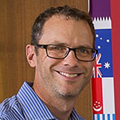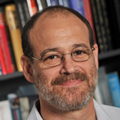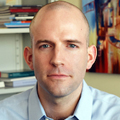Personal Mention
 Jay Whitacre, a materials scientist and professor in the College of Engineering, is the recipient of the 2015 $500,000 Lemelson-MIT Prize. Whitacre is the inventor of the Aqueous Hybrid Ion (AHI™) battery, a reliable, environmentally benign and cost-efficient energy storage system. This first-of-its-kind battery, often used in combination with solar and wind energy systems, stores significant amounts of energy at a low cost per joule and allows for around-the-clock consumption. Whitacre’s AHI™ battery, developed using abundant and inexpensive resources including water, sodium and carbon, can help reduce dependence on fossil fuels and make sustainable energy a viable alternative. The company that Whitacre founded, Aquion Energy, has fully scaled manufacturing and commercialized the battery with global distribution channels and installations in many locations including Australia, California, Germany, Hawaii, Malaysia and the Philippines. The Lemelson-MIT Prize honors outstanding mid-career inventors improving the world through technological invention and demonstrating a commitment to mentorship in science, technology, engineering and mathematics (STEM). Whitacre plans to contribute a significant portion of the money from the Lemelson-MIT Prize to create a fellowship to support graduate students and nurture interest in innovative energy solutions. Find out more.
Jay Whitacre, a materials scientist and professor in the College of Engineering, is the recipient of the 2015 $500,000 Lemelson-MIT Prize. Whitacre is the inventor of the Aqueous Hybrid Ion (AHI™) battery, a reliable, environmentally benign and cost-efficient energy storage system. This first-of-its-kind battery, often used in combination with solar and wind energy systems, stores significant amounts of energy at a low cost per joule and allows for around-the-clock consumption. Whitacre’s AHI™ battery, developed using abundant and inexpensive resources including water, sodium and carbon, can help reduce dependence on fossil fuels and make sustainable energy a viable alternative. The company that Whitacre founded, Aquion Energy, has fully scaled manufacturing and commercialized the battery with global distribution channels and installations in many locations including Australia, California, Germany, Hawaii, Malaysia and the Philippines. The Lemelson-MIT Prize honors outstanding mid-career inventors improving the world through technological invention and demonstrating a commitment to mentorship in science, technology, engineering and mathematics (STEM). Whitacre plans to contribute a significant portion of the money from the Lemelson-MIT Prize to create a fellowship to support graduate students and nurture interest in innovative energy solutions. Find out more.
 Mechanical Engineering Professor Yoed Rabin has received a $1.6 million award from the National Heart, Lung and Blood Institute of the National Institutes of Health to develop technology for cryopreservation, the preservation of tissues and organs at extremely low temperatures. This research will impact the future of biobanking and transplant medicine. Rabin is leading an interdisciplinary team that seeks to protect biomaterials from the harmful effects of ice crystals during cryopreservation, which is devastating to cells, tissues, and organs, to the point that they cannot regain viability and functionality after cryogenic storage. By introducing highly viscous solutions known as cryoprotective agents (CPAs) and rapid cooling, the biological material can be trapped in a glassy like state, in a process known as vitrification. The unique contribution of the current research is in the addition of synthetic ice modulators (SIMs), a special class of compounds which can create favorable conditions to deter the formation and growth of ice crystals. “There are more than 123,000 people on the waiting list for a lifesaving organ transplant in the United States, and another name is added every 12 minutes,” Rabin said. “Cryopreservation is the only alternative for long-term preservation of high-quality tissues and organs.” Find out more.
Mechanical Engineering Professor Yoed Rabin has received a $1.6 million award from the National Heart, Lung and Blood Institute of the National Institutes of Health to develop technology for cryopreservation, the preservation of tissues and organs at extremely low temperatures. This research will impact the future of biobanking and transplant medicine. Rabin is leading an interdisciplinary team that seeks to protect biomaterials from the harmful effects of ice crystals during cryopreservation, which is devastating to cells, tissues, and organs, to the point that they cannot regain viability and functionality after cryogenic storage. By introducing highly viscous solutions known as cryoprotective agents (CPAs) and rapid cooling, the biological material can be trapped in a glassy like state, in a process known as vitrification. The unique contribution of the current research is in the addition of synthetic ice modulators (SIMs), a special class of compounds which can create favorable conditions to deter the formation and growth of ice crystals. “There are more than 123,000 people on the waiting list for a lifesaving organ transplant in the United States, and another name is added every 12 minutes,” Rabin said. “Cryopreservation is the only alternative for long-term preservation of high-quality tissues and organs.” Find out more.
 Mechanical Engineering Associate Professor Steve Collins will be featured on a Fox episode of Xploration Station Earth 2050 this Saturday, Sept. 19. The program will air on many Fox affiliates around the country (except in Pittsburgh). The 30-minute segment will be about his unpowered exoskeleton technology (the walking assist clutch) and will include other demos of his work on prosthetics. You can view the segment Sunday night on HULU by searching for “Xploration Station Earth 2050.” Find out more about the program.
Mechanical Engineering Associate Professor Steve Collins will be featured on a Fox episode of Xploration Station Earth 2050 this Saturday, Sept. 19. The program will air on many Fox affiliates around the country (except in Pittsburgh). The 30-minute segment will be about his unpowered exoskeleton technology (the walking assist clutch) and will include other demos of his work on prosthetics. You can view the segment Sunday night on HULU by searching for “Xploration Station Earth 2050.” Find out more about the program.
Six CMU faculty appear on the new Thomson-Reuters list of the world’s Highly Cited Researchers in sciences and social sciences published this month. The CMU faculty on the list and the field in which they are most cited are:
- Neil Donahue, geosciences;
- Ignacio Grossmann, computer science;
- Rongchao Jin, chemistry;
- Gregory Lowry, environment/ecology;
- Krzysztof Matyjaszewski, chemistry; and
- Subra Suresh, materials science.
The list includes names of about 3,000 highly cited researchers in fields of the sciences and social sciences whose papers were in the top 1 percent of the most cited for their subject field and year indexed in the Web of Science. The 2015 list was based only on citations in papers published between 2003 and 2013. Details on the criteria and method for creating the list are available online.
